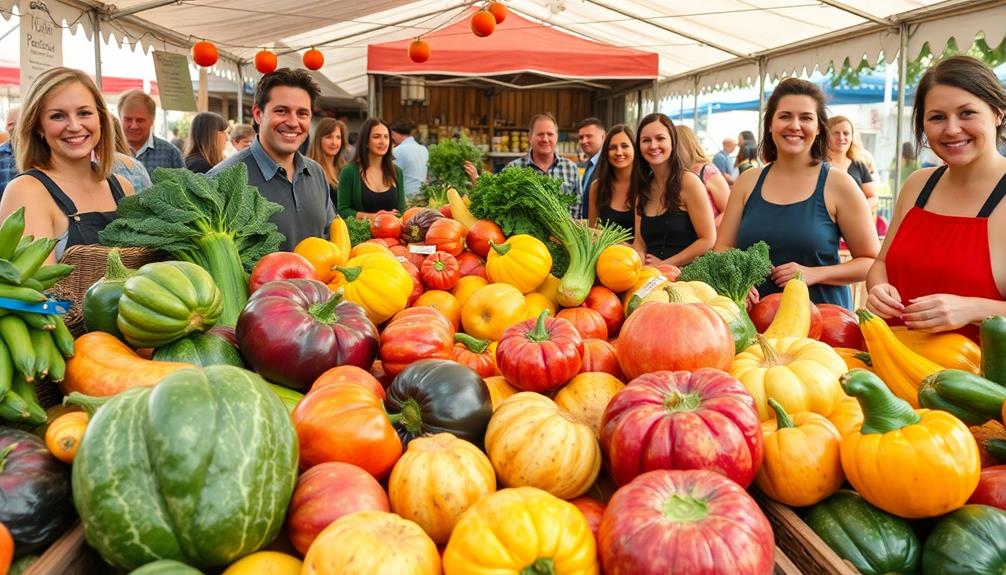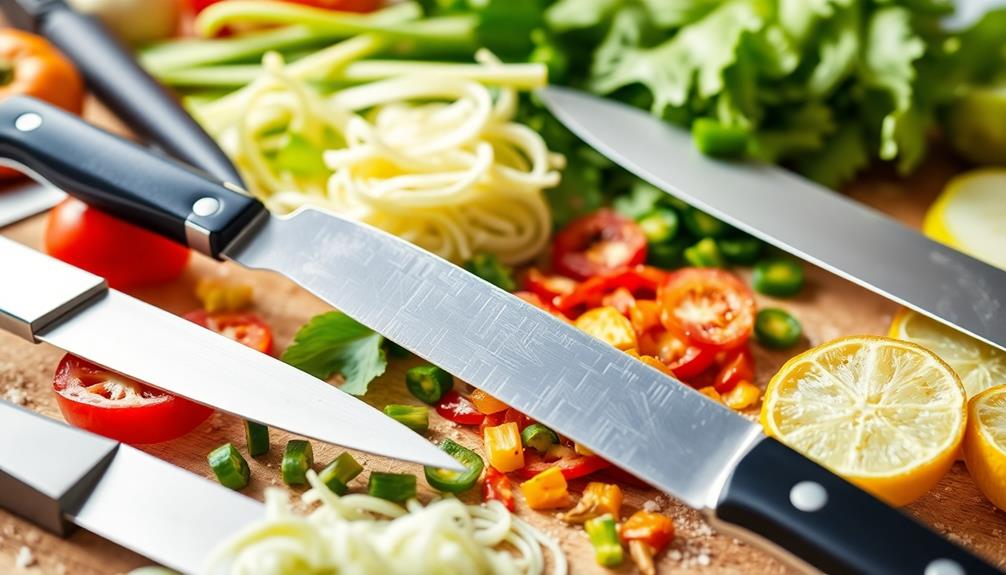The 'ugly food' movements are actively reshaping your views on food quality. You might find yourself less inclined to choose aesthetically imperfect produce due to the "beauty is good" bias. This bias leads to the perception that ugly food is of lower quality, despite equal nutritional value. As a result, nearly half of fruits and vegetables get wasted based on their appearance. Embracing these movements can not only save you money but also help reduce food waste. Curious about how to challenge these norms and make a difference in your choices? There's more to explore on this topic.
Key Takeaways
- The "ugly food" movement challenges aesthetic biases, encouraging consumers to reassess their perceptions of food quality based on appearance rather than taste.
- Educational campaigns highlight the nutritional equivalence of imperfect produce, fostering acceptance and reducing stigma associated with buying "ugly food."
- Marketing strategies that emphasize discounts on imperfect produce can effectively alter consumer behavior, making them more willing to purchase aesthetically flawed items.
- Engaging recipes and cooking demonstrations showcase the culinary potential of ugly produce, transforming consumer attitudes and promoting creative uses for suboptimal food.
- Increased awareness of food waste's environmental impact motivates consumers to choose ugly produce, aligning purchasing decisions with sustainable and ethical values.
Psychological Factors Influencing Food Choices
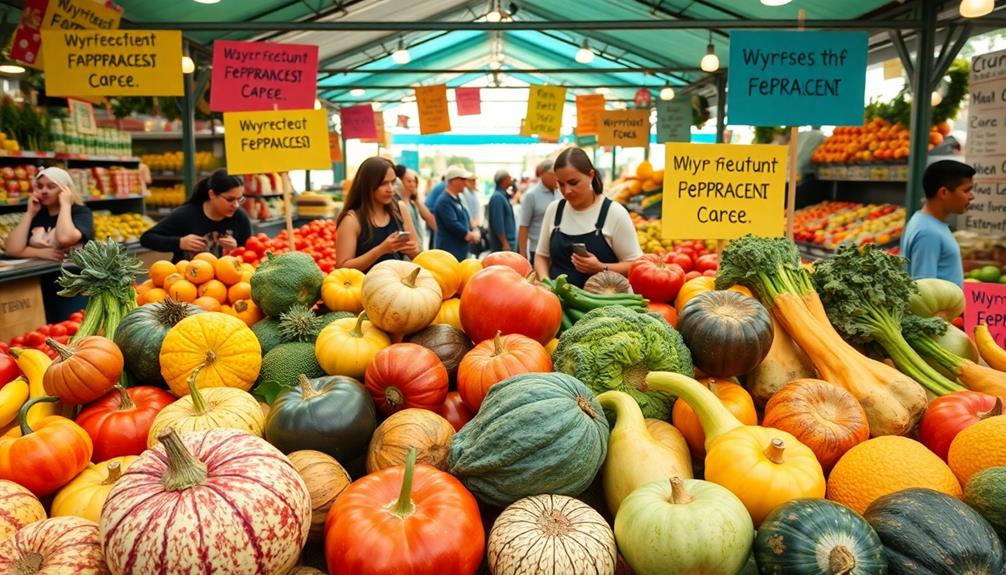
When you walk through the grocery store, you might notice how often visually appealing food catches your eye. This is no accident; psychological factors play a significant role in your food choices.
It's noteworthy that some delicious dishes, like Nettle and Potato Soup, mightn't always fit traditional beauty standards but are packed with nutrition. You mightn't realize it, but consumer perceptions are heavily influenced by the "beauty is good" bias, which suggests that attractive food is tastier and of higher quality.
Because of this, you might find yourself avoiding "ugly food," even if it has the same nutritional value as its prettier counterparts.
First impressions matter. When you see cosmetically imperfect fruits and vegetables, your immediate emotional response could lead you to dismiss them. This ingrained aesthetic bias and societal stigma can create misconceptions about food quality and safety.
As a result, ugly food often gets left behind in favor of more visually appealing options.
To challenge these perceptions, effective marketing strategies are essential. Highlighting the taste, nutritional benefits, and sustainability of ugly food can reshape your views.
Aesthetic Standards and Consumer Bias

You probably notice how societal aesthetic norms shape your choices at the grocery store. When you see produce that looks less than perfect, you might instinctively associate it with lower quality, despite knowing that taste and nutrition often don't differ.
For instance, many might overlook a dish like Red-Braised Pork Belly, which is rich in flavor and enjoyed during festivals, simply because it may not appear visually appealing.
This bias against imperfection not only affects what you buy but also contributes to alarming levels of food waste.
Societal Aesthetic Norms
In today's food culture, societal aesthetic norms heavily influence consumer choices, often leading to the rejection of "ugly" food. You mightn't realize it, but the appearance of ugly produce can trigger psychological biases that skew your preferences.
Many consumers mistakenly link aesthetics with quality and safety, causing them to overlook perfectly good fruits and vegetables. For instance, the vibrant colors and shapes of produce can distract from the rich flavors and nutritional benefits found in traditional dishes like Caldeirada and Tacac.
Consider these factors shaping your decisions:
- Beauty is good bias: You might perceive attractive food as more trustworthy.
- Wasted potential: Nearly 50% of fruits and vegetables produced are discarded due to aesthetic standards.
- Nutritional value: Ugly food often holds the same nutritional benefits as its visually appealing counterparts.
- Learned behaviors: Social norms condition you to favor standard produce over imperfect options.
- Effective marketing: Innovative communication strategies can reshape your perceptions of ugly food.
Visual Quality Perception
Visual quality perception plays an essential role in how you evaluate food, often overshadowing its actual taste and nutritional value. When faced with ugly fruits and vegetables, you might unconsciously associate visual appeal with food quality.
This bias leads many to believe that aesthetically pleasing produce is superior, causing you to overlook perfectly nutritious options that don't meet conventional beauty standards.
Surprisingly, nearly 50% of fruits and vegetables produced are wasted simply due to their appearance. This "beauty is good" bias influences your consumer behavior, making you more likely to reject imperfect produce. You may perceive unattractive items as inferior or risky, reinforcing the stigma surrounding them.
Emotional responses tied to food appearance greatly shape your choices. Visually appealing items trigger brain areas linked to pleasure and desirability, making you less likely to choose ugly produce.
However, effective marketing strategies that highlight the naturalness and taste of these items can help shift your perception. By embracing ugly fruits and vegetables, you can actively contribute to reducing food waste while enjoying nutritious options that deserve a place on your plate.
Bias Against Imperfection
Amid society's aesthetic standards, a strong bias against imperfection shapes consumer choices, often leading to the rejection of "ugly" food. This psychological bias, rooted in the belief that beauty equals quality, drives many to overlook nutritionally equivalent options.
Consider these points:
- Nearly 50% of fruits and vegetables produced go to waste due to consumer preferences for visually appealing items.
- Ugly food often contains the same nutritional value as its aesthetically pleasing counterparts.
- Color, shape, and texture notably influence your perceptions and acceptance of food.
- The stigma surrounding imperfect produce creates barriers, increasing food waste and economic inefficiencies.
- Educating consumers about the benefits of ugly food is essential for overcoming biases.
Your perception of food impacts the choices you make at the grocery store. By challenging these entrenched beauty standards, you can embrace ugly food and help reduce food waste.
Understanding that nutritional value isn't dictated by appearance is vital. In doing so, you'll not only support sustainability but also contribute to a more inclusive food culture that values all forms of produce.
Economic Impact of Ugly Produce
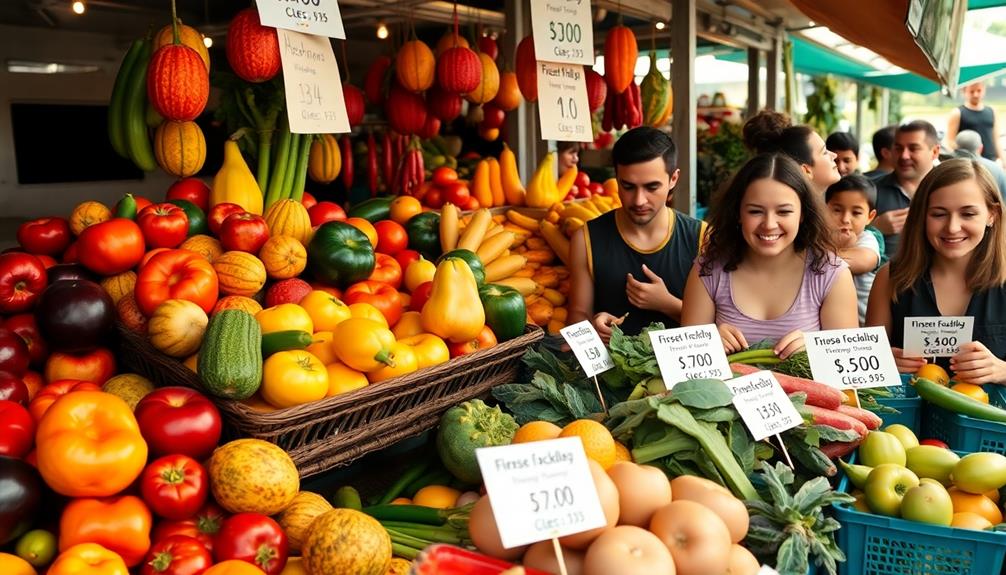
You mightn't realize that embracing ugly produce can lead to significant cost savings for you while also tackling the food waste crisis.
However, retailers still face challenges in meeting market demand for these imperfect fruits and vegetables.
Cost Savings Opportunities
Purchasing ugly produce can greatly cut your grocery bills, with discounts often reaching 30% or more compared to their pristine counterparts.
By choosing these imperfect items, you're not only saving money but also playing an essential role in reducing food waste.
Here are some benefits of buying ugly produce:
- Significant Savings: Enjoy price discounts on a variety of fruits and vegetables.
- Support Local Farmers: Help reduce the financial losses faced by farmers due to unsold ugly produce.
- Environmental Impact: Contribute to a sustainable economic model by reducing food waste, which constitutes 30-40% of total food supply in the U.S.
- Diverse Options: Discover a wider range of produce, often overlooked by retailers.
- Value Perception: Feel empowered as a consumer, knowing you're making a smart choice while saving money.
Market Demand Challenges
Despite the pressing need to reduce food waste, the market demand for ugly produce faces significant challenges. Many consumers still overlook unattractive fruits and vegetables, driven by aesthetic preferences that prioritize visual appeal over quality and taste. This reluctance contributes to the staggering $408 billion lost annually in the U.S. economy due to food waste, with nearly half of all fruits and vegetables produced discarded.
Retailers often reject non-standard produce, leading to financial losses for farmers and limiting the availability of discounted imperfect food. As a consumer, your purchase behavior plays a vital role in this cycle. If you're hesitant to buy ugly produce, you may inadvertently drive up costs for everyone, as the preference for pretty produce inflates prices.
To combat this issue, effective marketing strategies are essential. Retailers can help reduce food waste by promoting the nutritional equivalence of ugly produce and incorporating price cuts.
Retail Strategies for Suboptimal Food
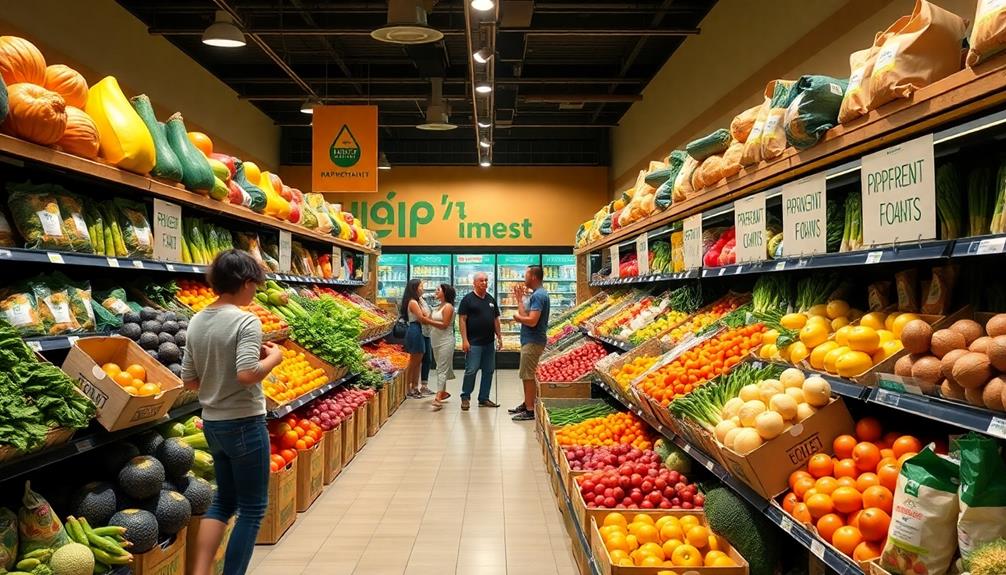
Retailers are increasingly recognizing the revenue potential of suboptimal food, often referred to as "ugly produce." By strategically merging standard and imperfect items, they cater to budget-conscious consumers while simultaneously addressing the pressing issue of food waste.
Implementing effective retail strategies can influence consumer behavior positively and reshape perceptions about aesthetically imperfect food.
Here are some key tactics retailers are using:
- Clear labeling: Price cuts and discounts on ugly produce can mitigate negative perceptions and encourage purchases.
- Mixed displays: Combining ugly produce with visually appealing items creates a favorable shopping context, boosting sales.
- Storytelling: Innovative marketing campaigns that highlight the sustainability benefits of ugly produce can foster consumer education.
- Sampling: Allowing consumers to taste ugly fruits and vegetables can shift attitudes and increase acceptance.
- Community engagement: Partnering with local organizations to promote food waste reduction can enhance brand image and attract environmentally conscious shoppers.
These strategies not only enhance revenue potential but also align with growing consumer interest in sustainability benefits, making ugly produce an attractive option for both retailers and shoppers alike.
Consumer Education and Awareness Efforts
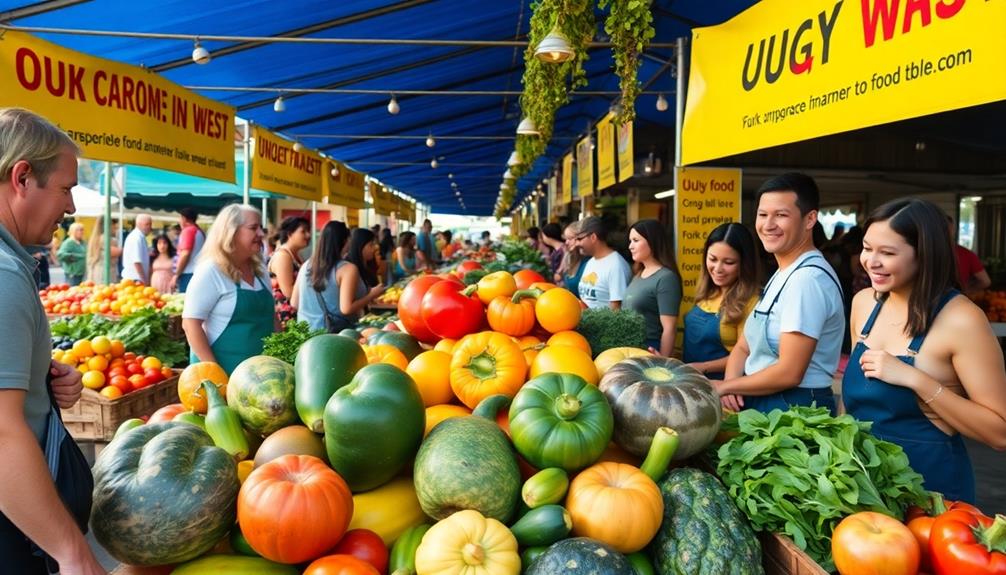
Awareness is key when it comes to embracing ugly produce and breaking down the stigma associated with food appearance. Consumer education plays an essential role in changing perceptions about imperfect fruits and vegetables. Many people don't realize that ugly produce offers the same nutritional quality as their more aesthetically pleasing counterparts.
By sharing engaging recipes and hosting cooking demonstrations, we can highlight the charm and culinary potential of these foods, making them more relatable.
Educational campaigns that emphasize the environmental impact of food waste are also important. With about one-third of all food produced globally going to waste, consumers can be motivated to choose ugly produce as a sustainable alternative. Clear communication about price reductions for these items can further mitigate negative perceptions, encouraging greater acceptance.
Additionally, increasing awareness of the societal stigma surrounding food appearance can help redefine beauty standards in produce. By valuing all types of fruits and vegetables, you not only foster a more inclusive perspective but also contribute to a significant reduction in food waste.
Embracing ugly produce isn't just a trend; it's a step toward a more sustainable and equitable food system.
Creative Uses for Imperfect Produce
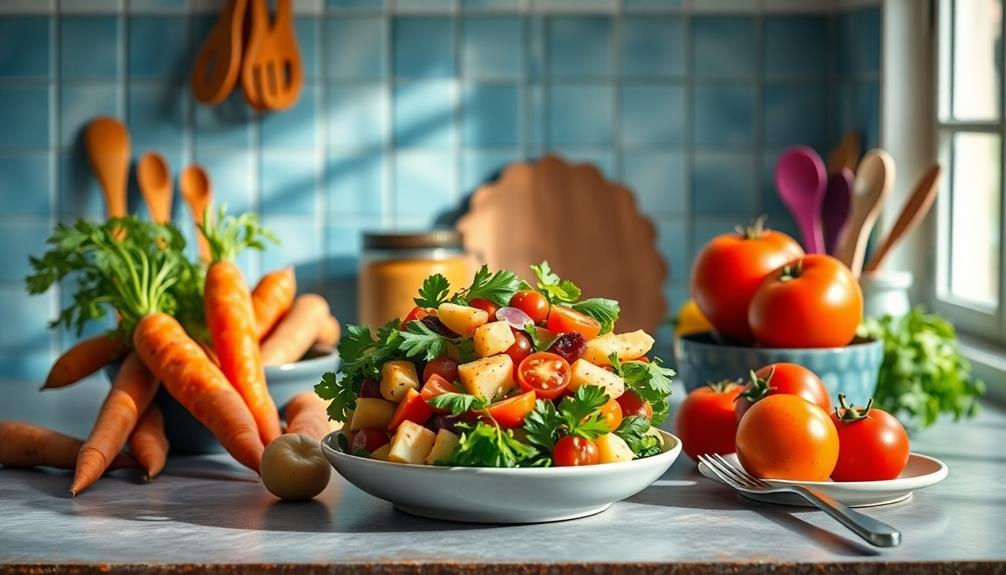
Imperfect produce may not look perfect, but it can be a culinary treasure waiting to be discovered. By exploring creative uses for these imperfect fruits and vegetables, you can enhance your meals while also playing a role in reducing food waste.
Here are some ways to embrace all types of produce:
- Soups and Stews: Blend those odd-shaped veggies into hearty soups.
- Smoothies: Toss in overripe fruits for a nutritious smoothie packed with flavor.
- Sauces: Create delicious sauces using bruised tomatoes or squishy peaches.
- Baking: Use imperfect fruits in muffins or cakes for natural sweetness and moisture.
- Cooking Classes: Attend workshops that teach you how to creatively utilize suboptimal produce.
Successful marketing campaigns are already changing consumer perceptions, showcasing how delicious dishes can be made from "ugly" ingredients.
When you embrace these culinary opportunities, you not only reduce waste but also inspire others to appreciate the versatility of all food appearances.
Frequently Asked Questions
Which Two Factors Contributed to the Start of the Ugly Food Movement?
The ugly food movement started due to widespread awareness of food waste and the economic appeal of buying imperfect produce at lower prices. You're encouraged to embrace these factors to support sustainability and reduce waste.
Why Are Some Consumers Reluctant to Purchase Ugly Food?
Why settle for less when beauty beckons? You might hesitate to buy ugly food, believing its appearance signals poor quality. Social pressures and aesthetic preferences often sway you away from these perfectly nutritious options.
What Is the Ugly Food Movement?
The Ugly Food Movement encourages you to embrace imperfect produce, reducing food waste. It highlights that these aesthetically challenged fruits and vegetables are just as nutritious, promoting sustainability while challenging societal standards of food beauty.
Why Did Uglyfood Fail?
You stroll through the market, your eyes drawn to the perfect apples, ignoring the oddly shaped ones. Ugly food's failure lies in your preference for beauty, overshadowing its value and potential to reduce waste.
Conclusion
In a world where beauty often reigns supreme, embracing 'ugly food' can be a revolutionary act—like taking a stand against the superficiality of modern life. By recognizing the value in these imperfect fruits and veggies, you're not just saving money; you're championing a movement that challenges societal norms. So, next time you see a quirky carrot or lumpy tomato, remember: true beauty lies beneath the surface, and your choices can help reshape the culinary landscape for the better.
